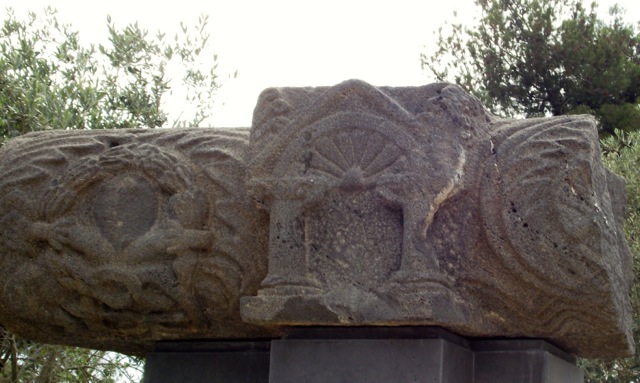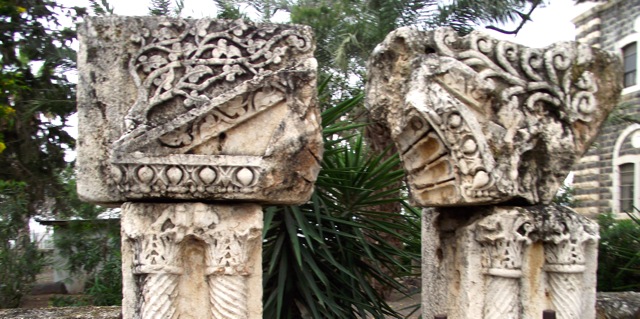Temple Icons
Icons related to the Temple were very common in the period of the Early Church because the Temple in Jerusalem was the center of the world. As with all icons, these symbols were easily recognized because most of the world at that time was very familiar with the Temple. The Temple icons represented familiar and significant aspects of the Temple.
Icons are not pictures. Many people become confused when trying to decipher icons because they try to understand the details as portrayals of the actual elements. Icons symbolically portray the significant and unique elements of a feature but not necessarily actual details. As we examine these Temple icons please keep in mind that these icons are not pictures but portrayals of significant elements.
The most common and most easily identifiable icons of the Temple are the representations of the two large pillars in front of the Temple. These two pillars actually had names. The name of the pillar on the right in the front of the Temple was Jachin. This is the English version of the name. Neither Hebrew nor Greek have a “J” sound. The Hebrew version of the pillar’s name is Yachin. The name of the pillar on the left was Boaz (I Kings 7:21).
Yachin and Boaz were very familiar landmarks in Israel in the first century. The original pillars made by Solomon were made of brass and were 18 cubits tall. A cubit is approximately 18 inches so the pillars were about 27 feet tall. The capitals that were on the top of the pillars were three cubits (or 4.5 feet) tall. This made the two brass pillars over 31 feet tall. These pillars are often represented with counter spiraling lines (I Kings 7:15). These huge shining pillars could be seen from a long distance. When a pilgrim saw these brilliant pillars, he knew he had found the Temple.
When King Nebuchadnezzar invaded Jerusalem in 587 B.C., he confiscated the Temple treasures to take them back to Babylon. The two pillars were so large that they could not be transported back to Babylon so the Chaldeans broke them so they could move the brass of the pillars. The only other item sieged from the Temple that was destroyed is the brazen sea (Jeremiah 52:17).
When the Jews returned from captivity in Babylon to Israel under the proclamation of Cyrus to rebuild the Temple, they took back everything that was taken from the Temple. We must assume they also took the broken pillars of Yachin and Boaz. They had to make new pillars for the Temple. We do not know if they melted the brass of the original pillars to make new ones or used a different material to make them.
The icons of Yachin and Boaz that represent the pillars in front of the second Temple that was rebuilt by Ezra are distinctly marked. The pillars in the front of the second Temple are represented by four pillars. Were there actually four pillars instead of two? Or did the icons of four pillars simply represent the pillars of the second Temple? Either way, the four pillars clearly distinguish the second Temple icons from the first Temple icons.
The second most common of the Temple icons from the first century in Israel is the triangle that stood on top of the Yachin and Boaz. Many falsely assume that this is a picture of the roof of the Temple. The problem with this assumption is the Temple did not have a pitched roof. According to history and the biblical description it had a flat roof. Icons are not pictures, they are representations. The triangle on top of the pillars, Yachin and Boaz, represents the Holy of Holies.
The icon that most commonly appears in the symbol of the Holy of Holies is the starburst. The starburst represents the Shekinah Glory of God radiating from the Ark of the Covenant. The starburst of the Glory of God appears many times without the triangular icon of the Holy of Holies but rarely does the Icon for the Holy of Holies appear without the Shekinah Glory of God.
The Temple icons are very common in ancient carvings and mosaics in Israel. The Temple was an integral part of the lives of believers for centuries before Christ, during the time Christ lived on this earth, and in the lives of believers in the Early Church. It is no surprise that these icons commonly appear in writings of the Early Church.
© Dr. Steven L Smith 2016

